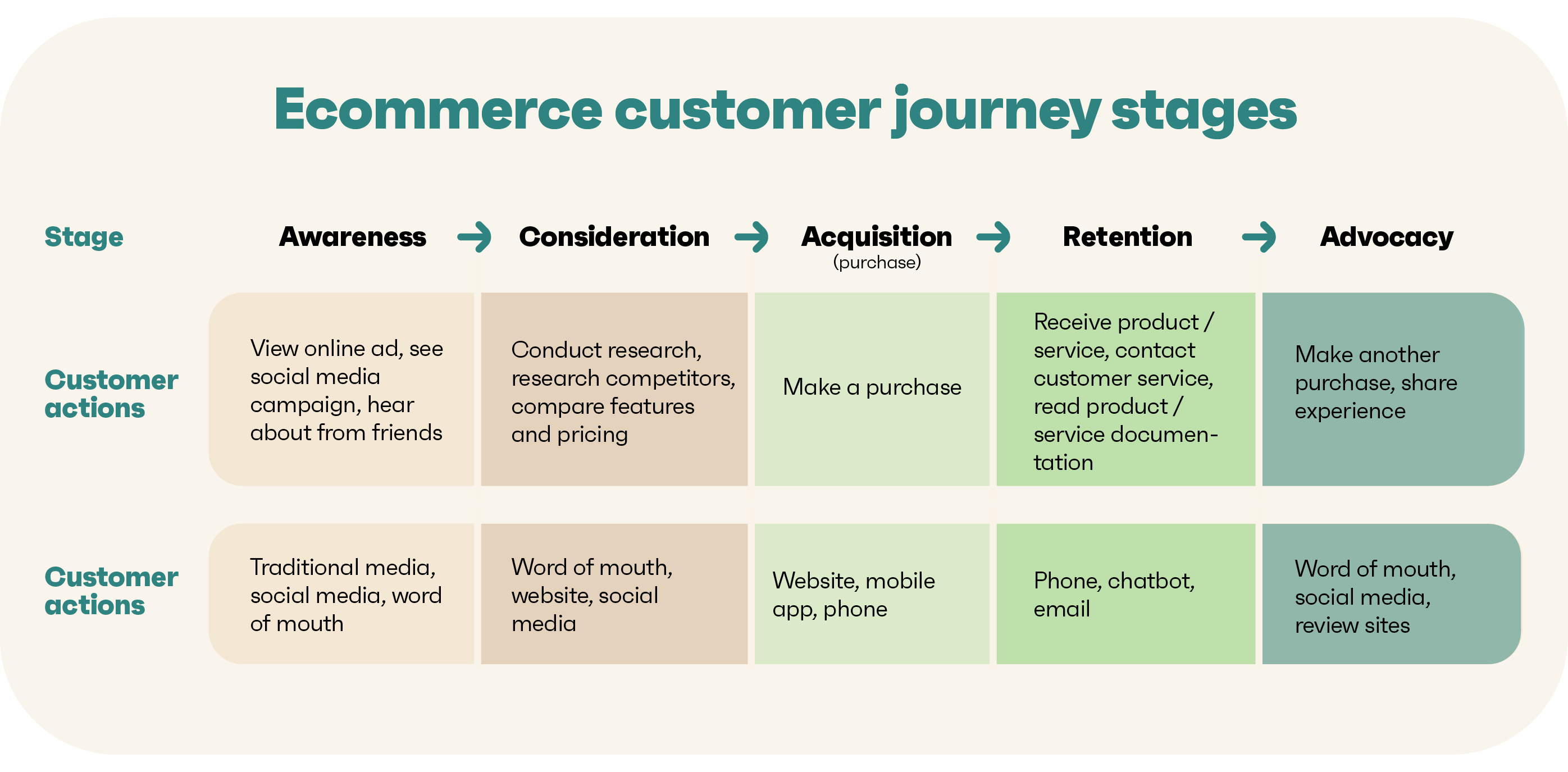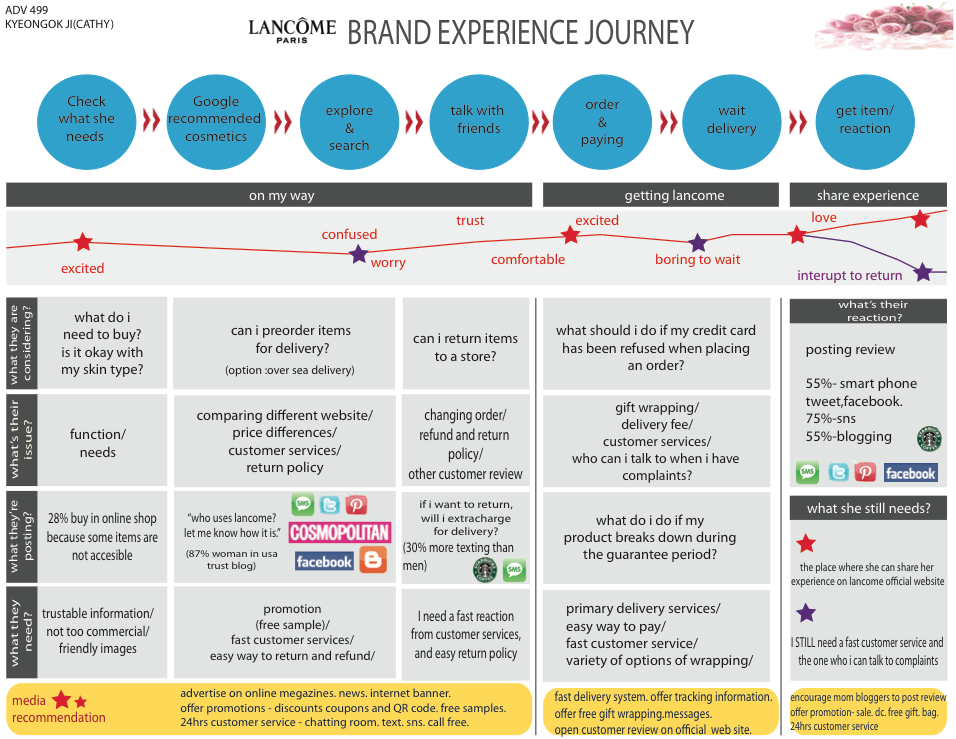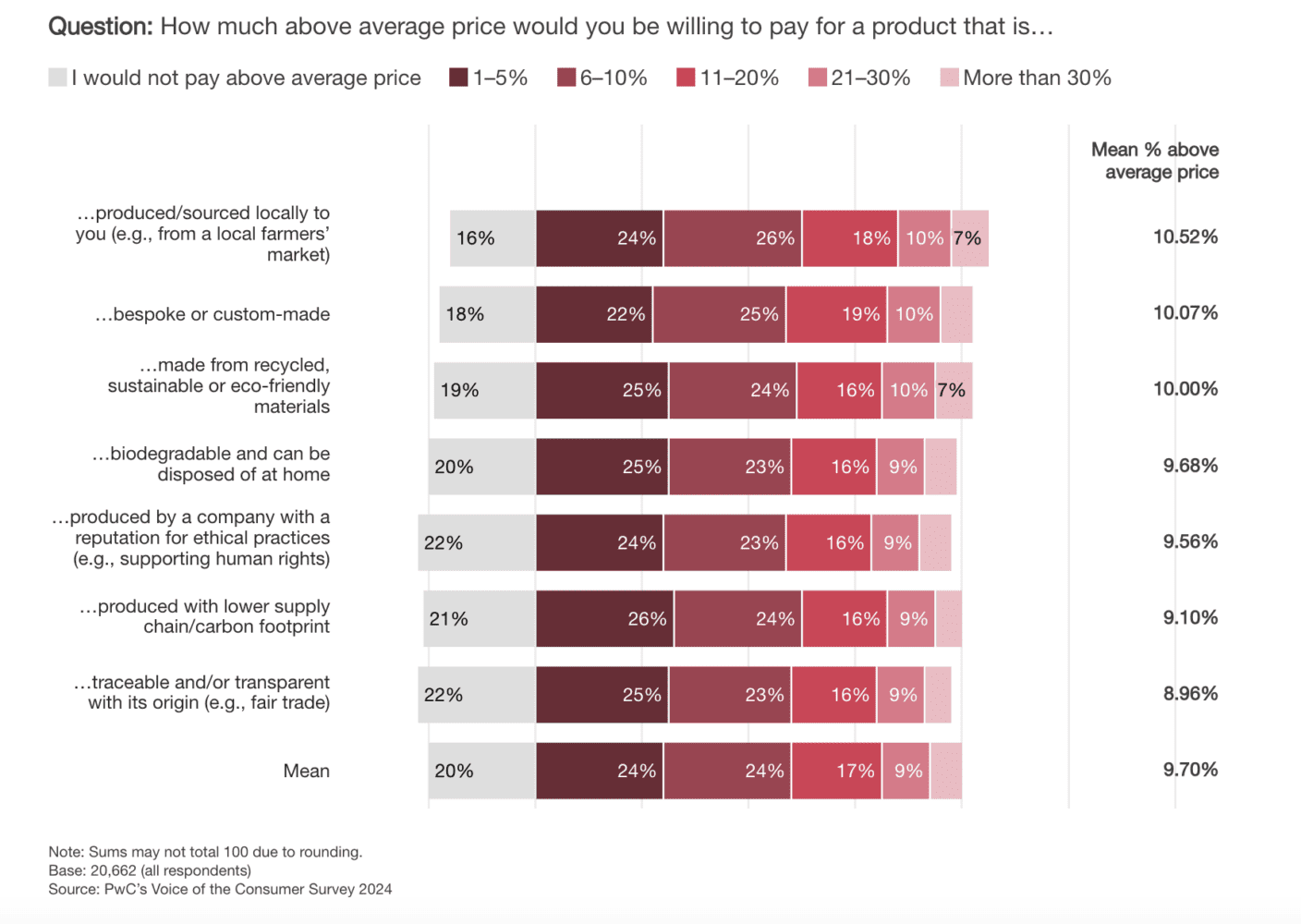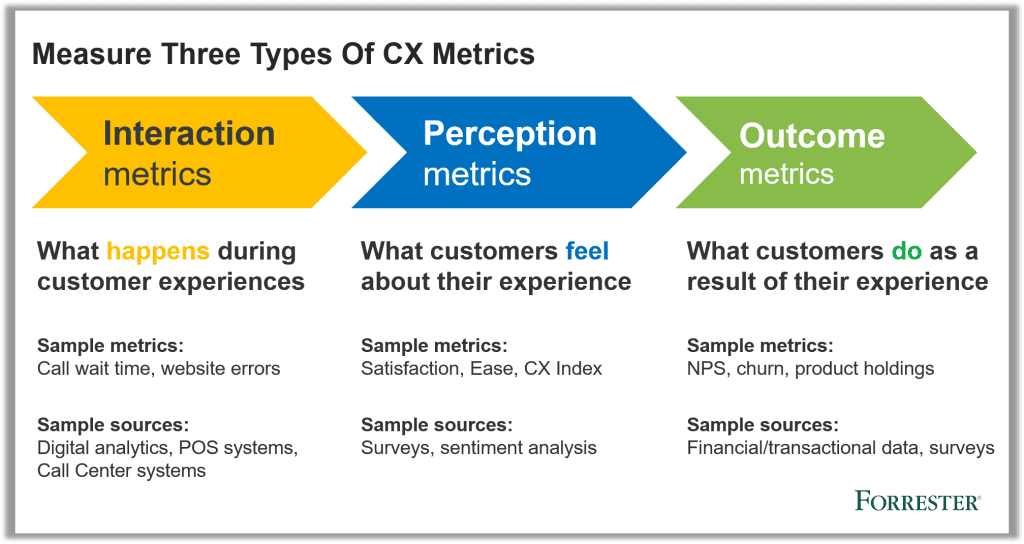You can be selling one of the most in-demand products on the market, but if your customer experience is poor, you’re losing out sales to your competitors. What is an e-commerce customer experience, and how do you improve it? This article offers nine tips — and one might just make you raise an eyebrow (in a good way).
What is an e-commerce customer experience?
E-commerce customer experience encompasses all the interactions and impressions a customer has with an online store. It includes everything from hearing about the brand and considering the product to buying and receiving it, as well as sharing their experience.
 Image source: Omnisend
Image source: Omnisend
3 undeniable benefits to a positive customer experience
Why is this important? Because by using a customer experience strategy, you can fulfill three long-term goals: standing out from competitors, boosting customer retention, and building strong customer loyalty. Let’s explore why they’re key and why ignoring them could be a costly mistake:
- A way to stand out from competitors. With endless choices at their fingertips, customers gravitate towards brands that offer more than just products. They want experiences that are seamless, enjoyable, and memorable.
- Boost in customer retention — and profits. Acquiring new customers is expensive. Why constantly chase new potential customers when you can turn existing ones into loyal fans? Happy customers spend more, buy more often, and are less likely to jump ship to your competitors.
- Strong customer loyalty. Loyal customers are your brand’s most valuable asset. They not only buy repeatedly but also become enthusiastic advocates, spreading positive word-of-mouth.
Still, while the concept of a positive customer experience seems obvious, execution is often challenging.
Why providing a positive e-commerce customer experience is also hard
In an ideal world, every business would prioritize positive experiences. Why wouldn’t they? Yet, it’s often not a top priority due to budget limits, resource constraints, or undervaluing its long-term benefits.
Consumer behavior is also increasingly unpredictable. As people navigate constant change from economic, social, and environmental forces, they’re more comfortable with paradoxical choices. Their decisions balance what they want, need, and what’s available, which makes it harder for businesses to consistently meet customer expectations:
 Data source: Accenture
Data source: Accenture
How to improve your customer experience
Providing a good e-commerce experience has obstacles, but it’s achievable. With the right tools and tactics, you can turn challenges into opportunities. Here are actionable strategies to get started.
1. Map the customer journey to proactively shape their experiences
E-commerce success hinges on understanding customers’ paths to purchase. A customer journey map visually represents their steps from brand awareness to post-purchase.
Natalie Thomas, Director of Digital Experience & UX Strategy at The Good, links customer journey maps to more sales:
“When you have a strong map, less customers drop out of the journey, and more make it all the way to the point of sale.”
Mapping means identifying “moments of truth” to win or lose customers. It helps you reveal:
- Actions: Steps customers take on your website or app
- Motivations and emotions: Their drivers and hesitations
- Questions and objections: Needed information and potential cart abandonment reasons
- Barriers: Technical issues, confusing navigation, or other obstacles

Image Source: The Good
Some tools can streamline the process:
- Collaboration platforms (e.g., Figma, Lucidchart) for real-time teamwork
- Dedicated journey mapping tools (e.g., Smaply, UXPressia) with persona creation and touchpoint analysis
- Comprehensive CX platforms (e.g., Adobe Experience Cloud, Microsoft Dynamics 365) integrating journey mapping with broader CX capabilities
Mapping the customer journey reveals critical touchpoints to improve — and user experience (UX) on your website or app is one of the most important.
2. Don’t overlook user experience on your website/app
People visit your website/app with a specific goal of learning about or buying your products. Helping shoppers achieve that goal easily is key. User experience lies at the heart of this. It encompasses all aspects of how a person interacts with and navigates your digital platforms.

Image source: Story of AMS
E-commerce agency Story of AMS highlights these common ways to improve e-commerce user experience:
- Prioritize functionality over aesthetics. Ensure your site works flawlessly before focusing on looks. A beautiful site is useless if tasks can’t be completed easily.
- Let copy and content lead design. People buy when they see clear value, not just nice design. Use text and visuals to guide users with clear, concise language that complements presented information.
- Intuitive navigation is key. Customers should quickly find needed products. Use clear labels, logical categories, and prominent search bars.
- Don’t forget mobile users. Optimize for mobile with responsive design, easy small-screen navigation, and fast loading on mobile connections.
- Show, don’t tell. People rely heavily on reviews. Highlight top testimonials and positive reviews to build trust.
Another crucial but often overlooked tactic is search functionality. The quicker people can find what they need, the faster purchases happen. Quicker search = more sales.
3. Provide seamless search functionality on your website/app
With more shoppers researching and buying online (63% of consumers have purchased products directly from a brand’s website in 2023), a great search experience is crucial for driving sales.
Baymard Institute’s usability research study on how users search and navigate e-commerce sites reveals these tips to improve search functionality:
- Understand the many ways people search. People describe the same product differently. Teach your search bar to recognize synonyms (e.g., “jumper” and “sweater”). Include related terms (e.g., if someone searches for “laptop,” also show them “notebook” or “computer”).
- Make sure your search catches typos. If your search doesn’t account for typos, shoppers may think you don’t have what they want. Understand common misspellings and offer suggestions like “Did you mean…?”
- Let shoppers refine searches easily. People often change their minds. Forcing them to retype is frustrating. Keep previous queries in the search bar so they can easily modify terms. Show their original search results, too.
- Include autocomplete functionality. Give hints as they type to help find what they’re looking for faster. Offer suggestions for search terms and specific products to help discover new items.
- Make the mobile search a breeze. Many people shop on phones. Make your mobile search prominent, with a clear button and suggestions/results optimized for small screens.
Nailing search functionality allows shoppers to easily find your products — removing a major barrier to purchase. But customer support is also key, which brings us to self-service.
4. Reinforce your customer support with self-service options
In 2024, customers prefer finding answers on their own over waiting for a live agent when they have simple questions or issues. Salesforce’s State of Service report states 59% prefer self-service, which is beneficial for businesses:
“When customers can interact with a chatbot to answer a question or use a guided journey to start a return, live agents have the time they need to manage more complicated requests.”
Self-service options like FAQ portals, chatbots, knowledge centers, and community forums significantly reduce costs and wait times while delivering convenience. For example, ASOS offers “Help Pages” for instant, 24/7 assistance, as well as a Virtual Assistant to answer questions not covered in the FAQ:
The key to reaping the value from self-service is making self-service options prominently visible on your website and app, with easy search to quickly find information. E-commerce companies can ensure strong self-service through customer service software like Intercom with its (what seems like) basic pricing plan.
Self-service empowers customers while freeing agents for complex issues. But it’s just one piece – personalizing the experience is also vital for improving CX.
5. Value personalized purchase experience above all
Finding strategies to personalize customer experience is crucial because 61% of consumers say they’ll stop using a brand if their experience isn’t personalized.
In the coming year, brands will see huge ROI by using AI to personalize the post-purchase experience, for example:
- Personalized shipping/delivery updates keep customers informed and engaged.
- Customized product recommendations based on recent purchases enhance additional sales.
- Personalized product care tips tailored to the specific item add value and show commitment to satisfaction.
- Intelligently timed requests for feedback/reviews increase engagement.
- Dynamic follow-up communications scheduled based on engagement patterns are more effective.
- Loyalty program personalization with relevant rewards based on purchase history/preferences.
- Predictive support queries anticipate and address potential post-purchase issues proactively.
6. Optimize product detail pages (PDP) content
 Image source: Syte
Image source: Syte
Data overload often leads to choice paralysis. This makes clear and effective product detail pages (PDP) crucial. 71% of shoppers have switched to competitors, which made it easier to find the right product.
Research by Zoovu highlights three opportunities for optimizing PDPs:
- Use generative AI for personalization. Only 16% of PDPs are currently personalized. Microsoft uses AI-powered Q&A assistants on retailer pages — after a product quiz, the AI explains why a specific laptop matches the customer’s needs. While requiring careful implementation to avoid AI risks like hallucinations and bias, this approach has a low barrier to entry.
- Prepare for machine customers. By 2030, intelligent virtual assistants acting for humans may make 25% of online purchases. E-commerce brands must adapt discovery journeys for these “machine customers”, translating overly technical filters into needs-based rules like “waterproof shoes”.
- Translate specs into use cases or benefits. Product specs are confusing jargon (I mean, what the heck is “E-TTL II Flash metering” or “Polyurethane foam lb/cu.ft”?). Translating these into clear benefits aids understanding, for example:

Source: Zoovu
7. Create a strong social media presence to connect with consumers
Recent research highlights social media as the epicenter of building brand-consumer trust that requires timely, genuine engagement from brands.
Jamie Gilpin, CMO at the SMM company Sprout Social emphasizes this:
“Today’s consumers want brands to do more than jump on trends and social issues – they want to trust and truly connect with a brand, requiring them to be more responsive and personal than ever. Social media is the channel for building that trust, and consumers expect a brand’s social presence to provide authentic communication and strong customer care.”
Don’t overlook social media’s power for enhancing e-commerce CX. Key trends to capitalize on are:
- Shifting content arena. User-generated videos like hauls and get-ready-with-me content supported by brands increase engagement. Using a YouTube video maker can help creators produce high-quality videos quickly, making it easier to maintain a consistent posting schedule.
- Differentiation. Twice as many consumers believe personalized care from brands is more memorable than content on trends and social issues, per Sprout Social’s data.
- Community-driven platforms. Invest in Facebook Groups, Discord servers, etc. For example, a record-breaking 20,000 users joined fashion marketplace StockX’s Discord within a day.
Building real connections on social channels fosters invaluable customer loyalty. But consumers also deeply care about another key factor…sustainability.
8. Highlight your sustainability practices — customers are willing to pay more for it
Going green is the new black for savvy e-commerce brands. Eight out of ten consumers say they would pay up to 5% more for sustainably produced goods:
 Source: PwC
Source: PwC
In an era of heightened environmental consciousness, consumers increasingly seek out brands that align with their values. This “green trend” reflects the growing demand for products that minimize waste, utilize eco-friendly packaging, and conserve natural resources.
Here’s how you could showcase your sustainability practices:
- Be transparent. Clearly communicate your sustainability efforts on your website and product pages. Explain how your products are made, the materials used, and the steps you’re taking to reduce your environmental footprint.
- Highlight certifications. If your products or practices have been certified by reputable organizations (e.g., Fair Trade, B Corp), display those badges prominently.
- Share your impact. Quantify the positive impact of your sustainability initiatives, e.g., state how much water you’ve conserved or how much waste you’ve diverted from landfills.
- Engage customers. Invite participation through recycling programs, cause support, sustainable use tips, etc.
Embracing transparency and highlighting your green initiatives builds trust with eco-conscious shoppers willing to pay more. So get sustainable — it’s a win for the planet and your bottom line.
Interestingly, creating just a little friction can also enhance the e-commerce customer experience.
Bonus tip: Create some friction (yes, you read it right)
While it might sound counterintuitive, strategically introducing friction into your e-commerce customer experience can be beneficial. This doesn’t mean making things difficult or annoying but encouraging thoughtful engagement and creating meaningful interactions.
How (and why) does that work?
Research from MIT Sloan reveals that a frictionless experience can lead to impulsive purchases and buyer’s remorse. Customers may not fully consider their options, ending up with unwanted products.
Adding a touch of friction can lead to:
- Better customer selection. A slightly more involved process attracts genuinely interested customers likely to become loyal.
- Improved satisfaction. When customers deliberate, they make better choices, reducing returns.
- Stronger brand connections. Friction creates opportunities to communicate values, engage uniquely, and foster deeper emotional connections.
Finding the right balance is key. Too much friction deters customers, while too little leads to impulsiveness and dissatisfaction. Take this assessment from MIT to determine the right amount of friction for your e-commerce customer experience.
How to create “good friction”
- Thought-provoking content. Use descriptions to spark curiosity about how products can benefit customers.
- Interactive elements. Incorporate quizzes, surveys, or comparison tools for informed decisions.
- Limited-time offers or exclusivity. Create urgency or exclusivity to motivate thoughtful action.
- Unique checkout process. Add charitable donation options or personalized messages to enhance emotional connection.
The most important metrics to measure e-commerce customer experience

Image source: Forrester Research
How do you know if your efforts to improve CX are hitting the mark? You need cold, hard data. For example, you can measure these metrics: NPS, CSAT, CES.
- Net Promoter Score (NPS) measures how likely your customers are to recommend your brand to others. It’s a simple question: “On a scale of 0 to 10, how likely are you to recommend us?”
Why it matters: High NPS scores indicate happy, loyal customers who are your best advocates, driving word-of-mouth marketing and repeat business. - Customer Satisfaction Score (CSAT) measures how satisfied customers are with specific interactions, like communication with customer support team or checkout. It’s usually a quick survey after an interaction: “How satisfied were you with your experience?”.
Why it matters: CSAT provides real-time feedback on pain points or successes in the customer journey. It allows you to address issues quickly and make improvements where they count. - Customer Effort Score (CES) measures how easy or difficult it is for customers to complete specific actions, like returns or finding information. It’s a question like, “How easy was it to complete your return?” with a rating scale.
Why it matters: A high CES indicates friction in your processes. By identifying these areas, you can streamline the customer journey.
Measuring customer experience is crucial, but it’s only one part of the equation. Behind the scenes, your e-commerce financial management practices play a pivotal role in shaping the overall customer experience. How?
The hidden CX champion: Financial management in e-commerce
While not the most glamorous aspect, nailing your financial management must not be overlooked. After all, keeping the books in order ensures everything else runs smoothly:
- Accurate financial tracking. With precise records, you can competitively price products, offer transparent billing, and process refunds swiftly – building customer trust.
- Better inventory management. Effective financial management helps track stock levels, forecast demand, and avoid stockouts so customers can easily buy what they want.
- Data-driven decision-making. Your financial data is a goldmine of insights. Analyzing sales trends, profitability, and spending patterns informs decisions on product selection, marketing, and service initiatives that directly improve the customer experience.
While unglamorous, keeping your financial house in order ensures the whole e-commerce operation runs smoothly for happy customers. It’s the hidden champion behind stellar CX. Ready to unlock its power? Start by exploring the best KPIs for measuring e-commerce success.
The information presented in this blog article is provided for informational purposes only. The information does not constitute legal, accounting, tax advice, or other professional services. We make no representations or warranties of any kind, express or implied, about the completeness, accuracy, reliability, suitability, or availability of the information contained herein. Use the information at your own risk. We disclaim all liability for any actions taken or not taken based on the contents of this blog. The use or interpretation of this information is solely at your discretion. For full guidance, consult with qualified professionals in the relevant fields.

